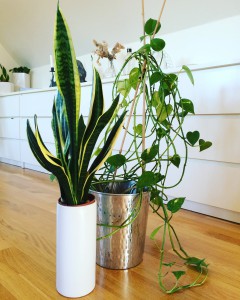 Jag har ju skrivit om hur dålig inomhusluften kan vara för din hälsa. Den är full med gifter från impregnerade möbler, plastprylar, elektronikprylar mm. Och i detta inlägg https://4health.se/superenkelt-satt-att-minska-gifter-i-ditt-hem skrev jag om hur vanliga krukväxter är superbra reningsfilter för inomhusluften.
Jag har ju skrivit om hur dålig inomhusluften kan vara för din hälsa. Den är full med gifter från impregnerade möbler, plastprylar, elektronikprylar mm. Och i detta inlägg https://4health.se/superenkelt-satt-att-minska-gifter-i-ditt-hem skrev jag om hur vanliga krukväxter är superbra reningsfilter för inomhusluften.
En indisk man vid namn Kamal Meattle har tagit det här längre. Hans lungkapacitet minskade till 70% av luften i Dehli i Indien, och läkarna sa åt honom att flytta. Men med familj och vänner på plats i staden tog han saken i egna händer. Hans studier ledde honom till tre vanliga, billiga krukväxter som inte bara renar luften utan producerar extremt mycket syre.
Nu ansvarar han för en stor byggnad i Indien som har mycket bra luft för alla de 300 personerna som huserar i byggnaden just pga dessa växter.
De tre växterna är:
1. Svärmorstunga – den här är dessutom utmärkt att ha i sovrummet eftersom den även nattetid producerar gott om syre
2. Gullranka (Money plant) – superbra i de rum du har mest elektronik eftersom den filtrerar bort de gifter som typiskt avges från datorer och annan elektronik
3. Arecapalm (tror det kan heta guldpalm på svenska, Dypsis lutescens)
Roligt att se att detta är just de växter som överlever i mitt hem eftersom de är så lättskötta 🙂 Jag hade verkligen alla tre, men palmen dog tyvärr nyligen efter många många år i samma jord och för lite kärlek
Nu har de fått duscha sina blad så att de är rena och kan göra sitt jobb extra bra!
Se/lyssna på Kamal Meattle’s 3minuters TED talk “How to grow fresh air” här nedan. Nedanför filklippet har jag även klippt in transcripts, dvs vad han säger.
Some 17 years ago, I became allergic to Delhi’s air. My doctors told me that my lung capacity had gone down to 70 percent, and it was killing me. With the help of IIT, TERI, and learnings from NASA, we discovered that there are three basic green plants, common green plants, with which we can grow all the fresh air we need indoors to keep us healthy. We’ve also found that you can reduce the fresh air requirements into the building, while maintaining industry indoor air-quality standards.
The three plants are Areca palm, Mother-in-Law’s Tongue and money plant. The botanical names are in front of you. Areca palm is a plant which removes CO2 and converts it into oxygen. We need four shoulder-high plants per person, and in terms of plant care, we need to wipe the leaves every day in Delhi, and perhaps once a week in cleaner-air cities. We had to grow them in vermi manure, which is sterile, or hydroponics, and take them outdoors every three to four months. The second plant is Mother-in-law’s Tongue, which is again a very common plant, and we call it a bedroom plant, because it converts CO2 into oxygen at night. And we need six to eight waist-high plants per person. The third plant is money plant, and this is again a very common plant; preferably grows in hydroponics. And this particular plant removes formaldehydes and other volatile chemicals.
With these three plants, you can grow all the fresh air you need. In fact, you could be in a bottle with a cap on top, and you would not die at all, and you would not need any fresh air. We have tried these plants at our own building in Delhi, which is a 50,000-square-feet, 20-year-old building. And it has close to 1,200 such plants for 300 occupants. Our studies have found that there is a 42 percent probability of one’s blood oxygen going up by one percent if one stays indoors in this building for 10 hours. The government of India has discovered or published a study to show that this is the healthiest building in New Delhi. And the study showed that, compared to other buildings, there is a reduced incidence of eye irritation by 52 percent, respiratory systems by 34 percent, headaches by 24 percent, lung impairment by 12 percent and asthma by nine percent. And this study has been published on September 8, 2008, and it’s available on the government of India website.
Our experience points to an amazing increase in human productivity by over 20 percent by using these plants. And also a reduction in energy requirements in buildings by an outstanding 15 percent, because you need less fresh air. We are now replicating this in a 1.75-million-square-feet building, which will have 60,000 indoor plants.
Why is this important? It is also important for the environment, because the world’s energy requirements are expected to grow by 30 percent in the next decade. 40 percent of the world’s energy is taken up by buildings currently, and 60 percent of the world’s population will be living in buildings in cities with a population of over one million in the next 15 years. And there is a growing preference for living and working in air-conditioned places. “Be the change you want to see in the world,” said Mahatma Gandhi. And thank you for listening.

Ampellilja och Dr Rosenlunds blomma (geranium/doftpelargonia) är andra bra luftrenare. 🙂